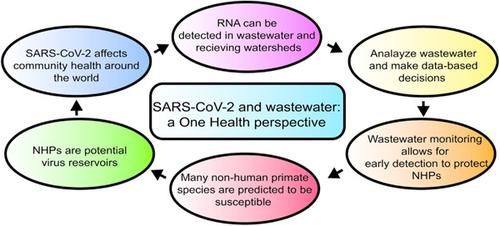当前位置:
X-MOL 学术
›
Am. J. Primatol.
›
论文详情
Our official English website, www.x-mol.net, welcomes your feedback! (Note: you will need to create a separate account there.)
SARS-CoV-2 and wastewater: What does it mean for non-human primates?
American Journal of Primatology ( IF 2.4 ) Pub Date : 2021-10-18 , DOI: 10.1002/ajp.23340 Sabateeshan Mathavarajah 1 , Amanda Melin 2 , Graham Dellaire 1, 3
American Journal of Primatology ( IF 2.4 ) Pub Date : 2021-10-18 , DOI: 10.1002/ajp.23340 Sabateeshan Mathavarajah 1 , Amanda Melin 2 , Graham Dellaire 1, 3
Affiliation

|
In most of our lifetimes, we have not faced a global pandemic such as the novel coronavirus disease 2019. The world has changed as a result. However, it is not only humans who are affected by a pandemic of this scale. Our closest relatives, the non-human primates (NHPs) who encounter researchers, sanctuary/zoo employees, and tourists, are also potentially at risk of contracting the virus from humans due to similar genetic susceptibility. “Anthropozoonosis”—the transmission of diseases from humans to other species—has occurred historically, resulting in infection of NHPs with human pathogens that have led to disastrous outbreaks. Recent studies have assessed the susceptibility of NHPs and predict that catarrhine primates and some lemurs are potentially highly susceptible to infection by the severe acute respiratory syndrome coronavirus 2 (SARS-CoV-2) virus. There is accumulating evidence that a new factor to consider with the spread of the virus is fecal-oral transmission. The virus has been detected in the watersheds of countries with underdeveloped infrastructure where raw sewage enters the environment directly without processing. This may expose NHPs, and other animals, to SARS-CoV-2 through wastewater contact. Here, we address these concerns and discuss recent evidence. Overall, we suggest that the risk of transmission of SARS-CoV-2 via wastewater is low. Nonetheless, tracking of viral RNA in wastewater does provide a unique testing approach to help protect NHPs at zoos and wildlife sanctuaries. A One Health approach going forward is perhaps the best way to protect these animals from a novel virus, the same way that we would protect ourselves.
中文翻译:

SARS-CoV-2 和废水:对非人类灵长类动物意味着什么?
在我们一生中的大部分时间里,我们还没有遇到过像 2019 年新型冠状病毒病这样的全球大流行。世界因此而改变。然而,受到如此规模大流行影响的不仅仅是人类。我们的近亲非人类灵长类动物(NHP)在遇到研究人员、保护区/动物园员工和游客时,由于具有相似的遗传易感性,也有可能从人类那里感染病毒。“人畜共患病”——疾病从人类传播到其他物种——历史上曾发生过,导致非人类灵长类被人类病原体感染,从而导致灾难性的疫情爆发。最近的研究评估了 NHP 的易感性,并预测卡他灵灵长类动物和一些狐猴可能非常容易受到严重急性呼吸综合征冠状病毒 2 (SARS-CoV-2) 病毒的感染。越来越多的证据表明,粪便传播是病毒传播中需要考虑的一个新因素。在基础设施不发达的国家的流域中发现了这种病毒,这些国家的原污水未经处理就直接进入环境。这可能会使 NHP 和其他动物通过废水接触而暴露于 SARS-CoV-2。在这里,我们解决这些问题并讨论最近的证据。总体而言,我们认为 SARS-CoV-2 通过废水传播的风险较低。尽管如此,追踪废水中的病毒 RNA 确实提供了一种独特的测试方法,有助于保护动物园和野生动物保护区的 NHP。未来的“同一个健康”方法可能是保护这些动物免受新型病毒侵害的最佳方法,就像我们保护自己一样。
更新日期:2021-10-18
中文翻译:

SARS-CoV-2 和废水:对非人类灵长类动物意味着什么?
在我们一生中的大部分时间里,我们还没有遇到过像 2019 年新型冠状病毒病这样的全球大流行。世界因此而改变。然而,受到如此规模大流行影响的不仅仅是人类。我们的近亲非人类灵长类动物(NHP)在遇到研究人员、保护区/动物园员工和游客时,由于具有相似的遗传易感性,也有可能从人类那里感染病毒。“人畜共患病”——疾病从人类传播到其他物种——历史上曾发生过,导致非人类灵长类被人类病原体感染,从而导致灾难性的疫情爆发。最近的研究评估了 NHP 的易感性,并预测卡他灵灵长类动物和一些狐猴可能非常容易受到严重急性呼吸综合征冠状病毒 2 (SARS-CoV-2) 病毒的感染。越来越多的证据表明,粪便传播是病毒传播中需要考虑的一个新因素。在基础设施不发达的国家的流域中发现了这种病毒,这些国家的原污水未经处理就直接进入环境。这可能会使 NHP 和其他动物通过废水接触而暴露于 SARS-CoV-2。在这里,我们解决这些问题并讨论最近的证据。总体而言,我们认为 SARS-CoV-2 通过废水传播的风险较低。尽管如此,追踪废水中的病毒 RNA 确实提供了一种独特的测试方法,有助于保护动物园和野生动物保护区的 NHP。未来的“同一个健康”方法可能是保护这些动物免受新型病毒侵害的最佳方法,就像我们保护自己一样。



























 京公网安备 11010802027423号
京公网安备 11010802027423号